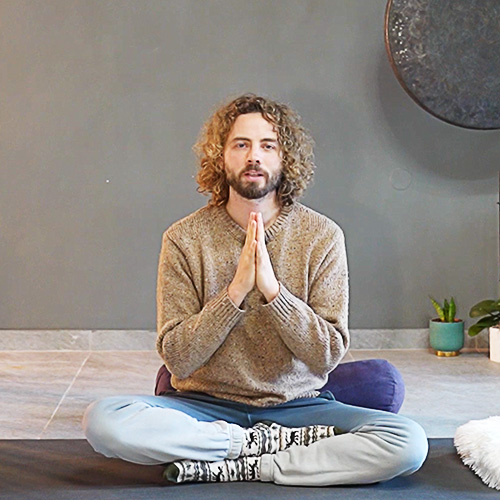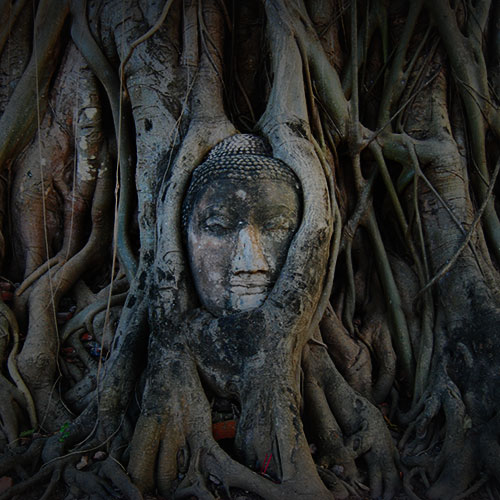If you are looking for the meaning of Sanskrit words, it means you are interested in Indian culture or are learning yoga. Today, we will discuss a few words that you will come across on your yogic journey.
1
OM (aum)
Many ancient philosophical texts consider Om to be the sound of the universe, embracing all other sounds within it. Om is known as Pranava in Sanskrit, which means "to hum," and is regarded as an infinite or eternal sound. Many cultures and religions adapted a very similar sound as their prayer, like Amen (sound almost like AUM) in Chrstianity.
2
Yoga (yoh -gha)
Yoga is derived from the Sanskrit word yuj, which means "to yoke" or "to unite." The practice seeks to unite the body, mind, and spirit, as well as the personal and universal awareness and consciousness.
3
Asana (ah -sun -ah)
Traditional definitions of asana include the seated position used for meditation and come from the Sanskrit word for "seat." Any physical Hatha yoga posture that can be found in all forms of yoga practice, including Vinyasa, Ashtanga, Restorative, and Bikram, is now commonly referred to by this term. Asana is frequently used as a suffix to a pose's name in Sanskrit. Although asana is currently the most well-known aspect of yoga, the tradition of yoga as a whole is thought to consist of much more than just asana. It is the third of Patanjali's Eight Limbs of Yoga.
4
Ahimsa (ah -himn -sah)
Ahimsa is a Sanskrit term that means "nonviolence." The term comes from the root word himsa, which means "to cause pain," and the prefix ‘a’, which means "not.” In broader way Ahimsa means "unified love and compassion", Ahimsa practice refraining from causing physical and psychological pain to any living being. Ahimsa is synonymous with forgiveness, divine love, and sacrifice. In a nutshell, Ahimsa is being nonviolent in thought and action, in body and soul.
5
Dharma (dhar -maa)
Dharma is a key concept in Hinduism, Buddhism, and yoga that refers to a universal law or principle. Individuals must follow this law to live their dharma. Along with Artha, Kama, and Moksha, it is one of Hinduism's four main philosophical principles. It is also a law of righteousness and truth, giving legitimacy to the customs, behaviors, and ethics that allow life to exist.
6
Ananda (aah -nun -dhah)
Ananda, which means "bliss," is the name of a disciple of Buddha who is credited with having the best memory for remembering his teachings. It could also be used with other words or names, like the well-known Parahamansa Yogananda.
7
Ashtanga (ush -tung -ah)
Ashtanga yoga, also known as Ashtanga Vinyasa yoga, is a style of yoga developed in the twentieth century by Sri K. Pattabhi Jois and T. Krishnamacharya. They claimed it descended from a Hatha yoga system described in the ancient text "Yoga Korunta."
The term Ashtanga yoga refers to this specific style of yoga when used in this context. Ashtanga yoga is an interactive, cascading style that connects body movement with breath. The method emphasizes the importance of practicing a set series of movements daily. There are six Ashtanga yoga sequences that the student works through at their own pace.
A second meaning and direct translation is "8 limbs". It comes from an old Yoga scripture called Yoga Sutras of Patanjali and describes an eigth fold path of following a yoga practice that leads to the state of Yoga.
8
Avidya (uh -vidh -yah)
Avidya means ignorance, misconceptions, misunderstandings, and incorrect knowledge. It is the inverse of Vidya.
It is extensively used in Hindu texts, including the Upanishads, as well as other Indian religions such as Buddhism and Jainism, especially in the context of metaphysical reality.
Avidya represents a fundamental lack of understanding and misperception of the phenomenal world in all Dharmic systems. However, the Indian religions disagree on the details, with Hinduism considering Atman (soul, self) denial and misconceptions as a form of Avidya, and Buddhism contemplating An-atman (non-soul, non-self) denial and misinterpretation as a form of Avidya.
9
Ayurveda (ayoor -vay -thah)
Ayurveda is an ancient Indian medical tradition. The term comes from the Sanskrit words ayur, which means "life" or "longevity," and veda, which means "knowledge" or "science."
Ayurveda is founded on two fundamental principles. The very first concept is that the body and mind are inextricably linked, and the second is that the mind has the power to heal the body. Only after one's awareness of oneself expands will the body be cured of illness. Yoga and Ayurvedic medicine are inextricably linked. Both have their origins in the Vedas. Ayurveda strives to keep the mind and body balanced so that the person stays healthy.
10
Bhakti (bhuck -thee)
The path of unwavering devotion to a particular god or deity, known as "bhakti," is thought to lead to salvation or nirvana. From the Sanskrit root word bhaj, which means "to adore or worship God," comes one of the yoga paths known as Bhakti yoga. Sometimes, the term "love for love's sake" is used to describe bhakti.
11
Brahma Nadi (bruk -mah nah -dee)
The brahma nadi is one of a body's network of channels through which energy travels. The words "brahma" means "divine" or "sacred" in Sanskrit, and "nadi" means "channel," "tube," or "flow".
The three main nadis that follow the spine in Hindu and yogic philosophy are ida nadi, also known as the left channel, pingala nadi, or the right channel, and sushumna nadi, or the central channel. The brahma nadi, a subtle channel, is located within the sushumna nadi. According to some traditions, the brahma nadi is thought to enclose the major chakras (centers of intense energy).
12
Chitta (chih -thah)
Chitta or citta means "consciousness." It derives from the root word cit, which means "to perceive." It is everything that is perceived and everything that can be perceived. Consciousness is the container for all perceivable things.
13
Chaturanga (chat-u-ranga)
Chaturanga is a movement in a yoga practice to move the body from plank to the ground or half way down. Mostly for a transition from downward dog to upward dog.
14
Dhyana (dheeah -nah)
The term dhyana means "meditation." It is derived from the root words dhi, which means "receptacle" or "mind," and yana, which means "moving" or "going." Dhyai, another root word, means "to consider."
15
Dharana (Dhaar -naa)
It is the sixth of Patanjali's Eight Limbs of Yoga, as described in the Yoga Sutras. It refers to mental concentration. Dharana involves focusing the mind on a specific object, which can be external (such as an image or deity) or internal (such as a chakra).
16
Drishti (drish -tee)
A yogic technique known as Drishti uses a focused gaze to enhance concentration. It can support the detachment of the senses for increased self-awareness and aid in increasing focus during yoga poses, yogic breathing, or meditation. It means "vision" or "eyesight," drishti is a practice that is said to support the development of wisdom and insight through the third eye. Drishti is not specifically mentioned in the Yoga Sutras, even though it is connected to pratyahara (sense withdrawal), the 5th of Patanjali's eight limbs of yoga.
17
Guru (goo -roo)
The term "guru" is commonly used to describe a "teacher" or "professor." However, in the yoga community, the term has a much wider definition. A yoga practitioner regards a guru as a highly regarded spiritual leader. In many yoga traditions, a type of interaction with one's guru is compared to a spiritual relationship and is regarded as necessary for achieving enlightenment.
18
Japa (Jah -pah)
A mantra or the name of a deity is recited aloud or silently during the ancient practice of Japa. The word is a translation of the Sanskrit word jap, which means "to repeat quietly and internally."
Japa yoga is a fusion of yoga and Japa. When regularly practiced, Japa yoga is thought to purify the mind, eliminate sins, and eventually lead to samadhi, or communion with God.
19
Jnana (gnyah -nah)
Jnana yoga is one of the four traditional schools of yoga, the others being Bhakti (devotion), Karma (action), and Raja (meditation), each of which offers a route to moksha (spiritual liberation) and self-realization. Jnana (Sanskrit for "knowledge" or "wisdom"), the conceptual path of scripture study and self-study, is one of the most direct and challenging routes to spiritual development.
20
Kosha (koh -shah)
Sanskrit's word for "covering" or "sheath" is kosha. The koshas are also known as the five sheathes as a result. The Upanishads define the koshas as a system of five levels of awareness that run from the physical body to the center of the self. Through the koshas that make up one's being, practicing yoga helps a person understand themselves better and gets them closer to their true Self.
21
Kundalini (koon -dah -lee -nee)
"Kundalini" is a Sanskrit word that means "coiled one." This expression refers to the primordial energy that is "coiled" at the base of the spine in spiritual circles. Through yoga postures, controlled breathing, and meditation, one can awaken the kundalini and direct its enlightening energy upward through the seven energy centers to the final chakra sahasrara at the top of the head.
22
Mantra (mun -thrah)
A mantra is a sacred word, sound, or phrase that is chanted in several spiritual and religious practices, such as yoga, Buddhism, and Hinduism. Sanskrit words manas, which means "mind," and tra, which means "tool," are the origins of the word mantra. Mantras are therefore viewed as "tools of thought" that are employed to regulate and focus the mind. When chanted with devotion, some utterances are thought to create powerful sensations in the body and mind that facilitate deep states of meditation. In the past, people believed that mantras have spiritual and psychological powers. Each mantra has a specific intention and meaning.
23
Mandala (muun -dha -lah)
A mandala is a geometric design that frequently has a circular shape and symbolizes the cosmos. The word in Sanskrit that is translated into English is either "circle" or "essence." Mandalas are used as sacred symbols in Buddhist and Hindu rituals. Yoga practitioners use mandalas as visual aids to help them focus during meditation.
24
Mudra (mooh -dhrah)
Mudras are sacred and symbolic hand positions that are used in yoga, Buddhism, Hinduism, and Jainism. The most common mudras are used in yoga and meditation to control the flow of prana, or life force energy The Sanskrit word is translated as "gesture," "mark," or "seal." There are thought to be 400 mudras that are accepted across many religious and spiritual traditions. In addition to being used as sacred and ritual gestures, they are also frequently used in Indian dance and the iconography of Indian religions. Each mudra has a unique symbolism and is thought to affect the body and mind differently by opening up full of energy channels. Along with the more well-known hand (hasta) mudras, yoga also employs body (kaya) and consciousness (citta) mudras.
25
Namaste (nuh -muss -thay)
Namaste is a combination of the Sanskrit words nama, which means "bow," and te, which means "to you." Namaste, a standard greeting and farewell in Hinduism, is a Sanskrit phrase that translates to "I bow to you." Namaste, on a deeper level, represents one soul acknowledging and respecting the holiness of another. Yoga instructors frequently offer the salutation at the start or end of a class. Namaste is used in this context to recognize the spiritual union, or oneness, attained by souls participating in yoga together.
26
Prajna (prugh -nah)
Prajna, in Buddhism, is the highest comprehension of the true character of presence and reality. Prajna is a state of individual consciousness that encompasses worldly concepts or belief systems that might obstruct perfect wisdom; it is a Sanskrit word derived from the word pra, meaning "beginning" or "premium," and jna, meaning "consciousness" or "understanding." To achieve enlightenment is regarded as direct foresight into the truth learned from the Buddha's teachings. Many people engage in asanas and meditation as part of spiritual yoga practice to reflect inward and progress toward prajna.
27
Prana (prah -nah)
The Sanskrit word "prana" can mean many things in English, such as "life force," "energy," and "vital principle." The phrase refers to all the manifest energy in the universe, which is present in both living things and inanimate objects and is used in Hindu and yogic philosophy. Yogis may want to learn more about prana to be able to increase and extend their energy and, as a result, enhance their health and well-being.
28
Pranayama (prah -nah -yah -mah)
Pranayama is a collection of techniques for capturing and manipulating prana, or unifying energy. It is an important part of yoga, frequently absorbed into asana practice or used as a warm-up before meditation. Pranayama is derived from several Sanskrit word, prana (vital life force), yama (control), and ayama (extension or expansion). Prana is represented by the breath, and pranayama can be defined as method of extending and expanding vital life energy through the focus of respiration.
29
Pratyahara (prut -yah -ha -rah)
Withdrawal of the senses is how most people translate the Sanskrit term pratyahara. It is the fifth of Patanjali's eightfold yoga path's limbs and is considered to be a crucial first step before the more difficult forms of dharana (concentration) and dhyana (meditation). The word is derived from two Sanskrit word, prati, which means "against" or "withdraw," and ahara, which means "food" or all things we consume from the outside. Pratyahara can therefore be interpreted as gaining control over or removing oneself from any outside influences.
30
Samadhi (sum -ah -thee)
According to Patanjali's Yoga Sutras, samadhi is the eighth and final stage of the yoga path. The term comes from several Sanskrit roots, including sam, which means "together" or "completely," a, which means "toward," and dhe, which means "put." The word samadhi has been translated as "enlightenment," "liberation," or even "bliss." Samadhi is regarded as the highest level of all intellectual and spiritual endeavors in both Hinduism and Buddhism. It is also a requirement for achieving samsara (release from the cycle of death and rebirth). According to yoga, it is the point at which a person's consciousness merges with all consciousness. Samadhi has a profound spiritual meaning because it encompasses self-realization and represents the closest possible relationship with the Divine.
31
Samskara (sum -skah -rah)
According to various schools of Indian philosophy, samskaras are the subtle mental imprints left by all thoughts, intentions, and actions that a person has ever experienced. They can be viewed as emotional or psychological imprints that contribute to the development of behavioral patterns. They're frequently compared to mental grooves. It is believed that samskaras are the root of all urges, character traits, and innate dispositions. They exist at a level below that of regular consciousness.
The word "samskara" in Sanskrit has two roots: "sam," which means "well planned" or "well thought out," and "kara," which refers to "the action undertaken." As a result, it is believed that conscious actions have the biggest impact because the imprints they leave behind are the easiest to find and replicate.
32
Satya (sahth -yah)
The Sanskrit word Satya refers to a virtue that can be found in many different Indian religions. It translates to "truth" in the English language. In a religious context, the term "satya" refers to being sincere and truthful in one's actions, speech, and thoughts. According to the yogic philosophy set forth by Patanjali in the Yoga Sutras, this is one of the five yamas, or guidelines for ethically conducting oneself.
33
Shakti (shuck -thee)
The Hindu goddess Shakti is in charge of all dynamism in the cosmos and creation. She is also known as The Universal Mother or The Great Divine Mother. To comprehend and gain access to the shakti energy, power, and creativity present in both themselves and the universe, yogis who practice Tantra yoga and meditation contemplate the goddess Shakti. This enables one to see their abilities as manifestations of the cosmos rather than of the ego.
34
Sutra (soo -thrah)
Hinduism and Buddhism both have short verses or scriptures called sutras. Sutra means "note," "sacred thread," or "code" in Sanskrit. Sutras are frequently cited during meditation and chanting. The sutras serve as a manual for life for many people who practice spiritual yoga.
35
Swadhyaya (swahthee -yah -yah)
Hinduism uses the Sanskrit word svadhyaya to refer to the study of oneself. The word is derived from the Sanskrit word adhyaya, which means "lesson," "reading," or "lecture," and sva, which means "self" or "own." It can also be seen as deriving from the root dyhai, which denotes contemplation or meditation.
36
Tapa (thah -pah)
Tapas are spiritual exercises that frequently call for intense self-control, solitary time, and extended periods of deep meditation. The word tap, which means "to be hot," is a Sanskrit root. In light of this, the word is associated with the idea of spiritual enlightenment and the internal fire required to achieve it.
37
Viveka (vih -vay -kah)
The Sanskrit word "veka" can be translated as "discrimination," "right understanding," or "discrimination knowledge." One of the four characteristics of a spiritual disciple is this. It is the capacity to distinguish between what is real and what is unreal, permanent and transient, one's self and other people, and pleasure and bliss. The practice of realizing the Truth and the Soul is spiritual.
38
Yama (yah -mah)
A yama is a responsibility or behavior that the eight-limbed path of yoga recommends as a part of its philosophy and teaching. As his first "limb" of yoga, Patanjali lists the five yamas in his Yoga Sutras. The word "yama," which originally meant "bridle" or "rein," alludes to the yamas' restraint. These yamas are actions that are regarded as extracurricular rituals. They serve as a means of translating yoga's behavioral norms into the way yogis interact with the outside world. They are regarded as a priceless and extremely pertinent resource to aid yogis in leading moral lives.
39
Yantra (yahn -thrah)
A mystical diagram known as a yantra is used for worship in Indian religions and philosophy. It is used for meditation assistance and the alleged occult advantages based on Tantric texts and Hindu astrology. It is a particular kind of mandala, a religious image that symbolizes the cosmos. The word "yantra" means "instrument," "apparatus," or "contrivance" in classical Sanskrit. The word's come from, yam, has the meaning "to sustain the essence of an object or concept" or "to support an object or concept."
40
SO HUM (so -hum)
SO HUM is a often used mantra with the very simple meaning of "that I am" or "I am that". In the traditions some use it in as SA HUM, or even HAMSA. The different variations are related to the sanskrit language (female and male expression) and what the teachings want to refer to. With this mantra you want to connect to your inner most being while accepting the present moment fully as the way it is.


 90 min
90 min



































 read more
read more







